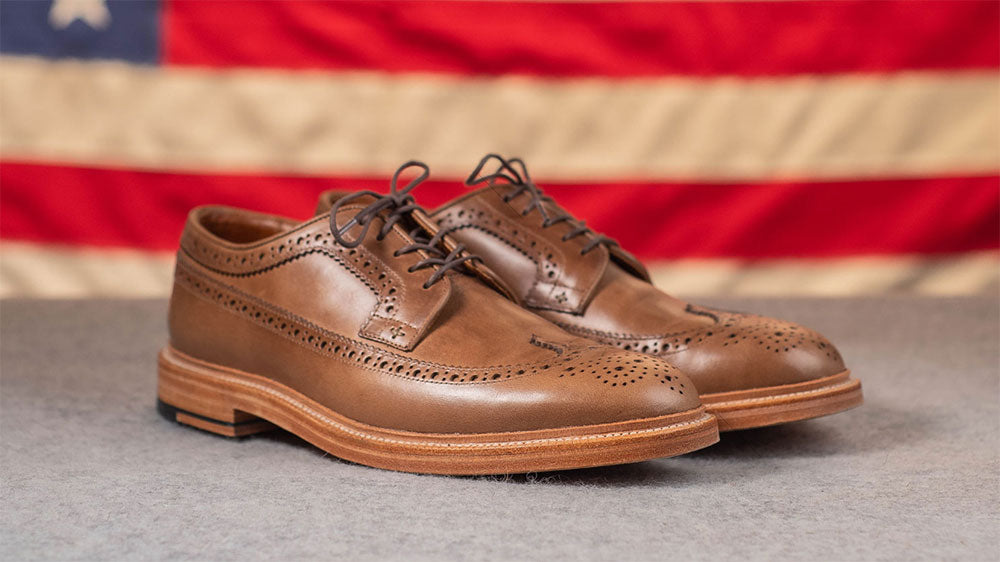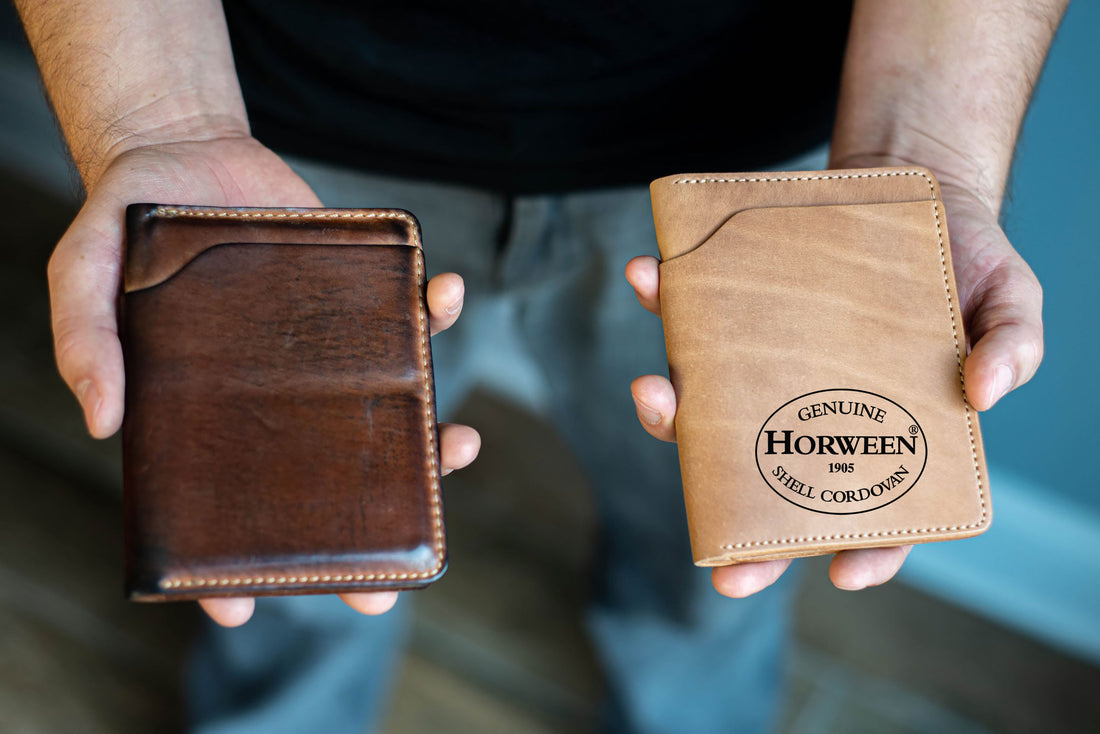One of our most frequently asked questions is, "What is the difference between shell cordovan and Chromexcel leather?". Simply put, both leathers are two of the finest in the world but shell cordovan is 10x the price. Why is it so much more expensive?
Shell cordovan is widely regarded as the finest leather in the world because of its bright luster, non-creasing grain character, great leather smell, durability, and ability to develop and keep these characteristics over time. However, it should not be overlooked by other leathers like Chromexcel. Both have their own unique qualities and values.

Horween Chromexcel
Chromexcel (aka CXL leather) is the classic “pull-up” leather meaning that, when folded and flexed, greases that were impregnated into the skin migrate causing a very nice tonal effect and beautiful depth of color. It also has a very bright luster or can be left unpolished to have more of a matte finish look. Chromexcel is a very versatile leather and is often found in boat shoes, classic shoe styles from Alden and Allen Edmonds, and many belts and small leather goods. Chromexcel has a “refined ruggedness” and will quickly develop character and having similar aesthetics to your grandfather’s old wallet very quickly.
What about the hides? Horween Chromexcel is most often found on steerhides. However, it can also be produced on horsehides, bison, and cowhides. Each animal's grain character and thickness is different. Steerhides tend to have the most clean grains and thickest hides. Horsehides have rough grain and are very thin.
Horween CXL leather is a combination tanned leather. It is a chrome base tannage with a vegetable retannage. With this combo you get the best of both worlds: strength and resilience from the chrome and natural character, ability to mold and form, and patina potential from the veg tanning. Additionally, CXL is hot stuffed with a rich blend of cosmetic grade waxes, oils, and greases. This hot stuffing blend gives the leather a rich hand feel, exceptional color depth, and a glowing luster.

CXL Pros
- Beautiful color depth
- Subtle luster
- Heat resistant
- Molds and conforms to shapes
- Rich, waxy and oily feel
- Versatile style
- Self-Polishing
- Patina potential
- Can take a beating: Scuffs and scratches can be polished in
CXL Cons
- Dents, scuffs, and scratches easily
- Heavy in mass
- Very rich in oils - color crocking can be bad for light colored clothing
- Can have loose grain. Experienced crafter required.
- Only available in earth tone colors
Chromexcel is only made by Horween Leather Co. in Chicago where it has been being made consistently since the early 1900’s. The process in creating a piece of Chromexcel takes 89 separate processes (many of which are completely by hand) and takes 28 working days to complete. Unlike many leathers, Chromexcel is air dried which allows the leather to shrink back on itself. Many tanneries will cringe at this concept because it decreases the yield (tanneries sell leather by the square foot) but also gives the leather a tighter, more calf-like, break as opposed to other drying methods like pasting or vacuum drying. Chromexcel and shell cordovan will scratch and scuff rather easily and, due to the high grease content, these scratches can be buffed out rather easily. However, shell cordovan is the only leather where you can completely remove a scratch.

Horween Shell Cordovan
Shell cordovan was originally produced to hone straight razors as it was used for razor strops in the early 1900's. It has been made on a daily basis in Chicago by Horween since 1905. Shell cordovan is like a great wine that only gets better with age, except you can drink it every single day.
It's definitely the best leather to use in any small leather good, especially for a wallet. The action your pocket has on the wallet with daily use leads to a polishing effect which allows the vegetable tanned shell cordovan to develop an amazing patina over time. As mentioned above, shell cordovan has a very beautiful mirror-like luster which can be brought back forever using different polishing methods. At Ashland Leather Co. we use a modified version of the Mac Method to polish our wallets, along with Saphir Cordovan Creme — This involves moisture, a lot of brushing, and a very small amount of polish.

Shell Cordovan Pros
- Never creases
- Exceptional durability
- Dramatic patina
- Porous and breathable
- Self Polishing
- Mirror-like luster
- Ability to mold and form
- Versatile: Can be dressed up or down
- Intoxicating scent
- Scratches can be easily filled in
Shell Cordovan Cons
- Very expensive
- Will dent, scuff, and scratch
- Not resilient to heat
- Only available in earth tones
- Odd shapes, small yield, varying thickness (requires highly skilled craftsperson)
Cordovan has a very unique feature of not creasing — if you look at many pairs of leather shoes where the toe flexes just above the toe box and below the laces you will see a pebbled effect. What is happening is that, after flexing and long periods of use, the grain layer of the leather is separating from the fiber layer of the skin which creates a sometimes undesirable/inconsistent pebbled look. Shell cordovan will never pebble because we are not using a grain layer at all — the unique fiber structure of the shell cordovan is found under the skin of any equine animal’s hind quarter (yes, shell cordovan is horse butt). These shells are oval shapes and there are approximately two square foot ovals in each horse (as opposed to a 50 square foot bovine hide). Handling and processing these significantly smaller pieces leads to a higher cost, as does the extensive 6-month (mostly by hand) tanning process.



Watch on YouTube


1193 comments
PseRJGiNEmucyX
jMFWOHgJCRizyNhs
ZNwhuIDGYArFWas
ZWAVnTqoYRhiOy
YOmqXntMUvH